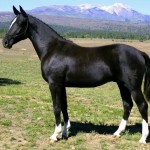Danish Warmblood
The Danish Warmblood is a modern breed that was intended to meet the demand for competition horses. This horse is Denmark’s modern sports horse breed. Produced by crossing the native Danish mares with the elite stallions with European bloodlines, these horses are famous for their spiritedness and courage. This versatile breed of horses is commonly seen in general riding, dressage, and other jumping activities.
Danish Warmblood Horse
- Black Danish Warmblood
- Chestnut Danish Warmblood
- Danish Warmblood Foal
- Danish Warmblood Horse
- Danish Warmblood Horses
- Danish Warmblood Images
- Danish Warmblood Jumping
- Danish Warmblood Pictures
- Danish Warmblood Stallion
- Danish Warmblood
Quick Information
| Other Names/Nicknames | Dansk Varmblod |
| Behavioral Characteristics | Courageous, spirited, multi-talented, loyal, easily trainable, intelligent, obedient, have excellent temperaments and good free action |
| Physical Descriptions | Large framed horses, with well-defined heads, large eyes; shoulders are long and sloping with defined and pronounced withers giving a favorable position to place the saddle; necks are muscular with good length of rein, chest is deep and broad, while back is strong and compact |
| Colors | Any solid color. Commonest colors are bay, black, chestnut, dark brown |
| Common Uses | General riding, dressage, jumping |
| Lifespan/Expectancy | 25-30 years average |
| Weight | 400-500 Kilos |
| Height (size) | 15.3 to 17 hands (both studs and mares) |
| Health Problems | Generally healthy, no consistent genetic issues associated with the breed |
| Movements | Gaited |
| Blood Type | Warm-blooded |
| Ancestors | Thoroughbreds, Anglo-Norman horses, Trakehners |
| Popular Traits | Easily maintainable, strong and hardy, multi-talented, good endurance |
| Feeding/Diet | General horse diets consisting of hay, grass, grains, vegetables, etc. |
| Country of Origin | Denmark |
| Year/Time of Development | Mid 20th Century |
Danish Warmblood Video:
History and Development
In 1962, in Denmark, the Danish Warmblood was developed for the first time by selective breeding. Initially, the Frederiksbork horses were made to breed with the Thoroughbred horses, producing a group of new foals. From this group of young horses, the mares were separated and crossed with the Anglo-Norman horses, Thoroughbreds, and Trakehners, resulting in the development of this new breed, the Danish Warmblood. Danish breeders succeeded in developing a competition horse in a relatively shorter period of time which they claimed to be of more versatile abilities and superior quality than many other breeds of European horses.
Until 1980, the Danish Sports Horse was known as the Danish Sports Horse. The registry for the Danish Warmblood was established in the latter half of the 20th century. Initially, there were two associations of the Danish saddle horse breed, viz. the Danish Light Horse Association and the Danish Sports Horse Society. However, in 1978, these two organizations merged into one, forming the ‘Dansk Varmblood’ (the Danish Warmblood Society) in Denmark. This registry supervises registration of new colts as also approves Danish Warmblood stallions for the purpose of breeding.
Among all breeds of European warmblood horses, the Danish Warmblood is the youngest. However, Denmark is very choosy about including the stallions in breeding. Though a North American Danish Warmblood Association was formed in 2001 in order to promote the Danish Warmblood in the U.S., the breed is still not very common in the US.
Before 2004, the purpose of the Danish Warmblood Society was breeding a versatile sports horse. However, in more recent times, the breeding has been more specific in creating a top show jumper or dressage horse.
Interesting Facts
- Around 3,500 Danish Warmblood foals are registered every year.
- The young horses with approved pedigrees may receive a brand depicting a crown over a wave.
- The crown that is given to these horses was drawn by I. C. Christensen and designed by Georg Jensen silver smithy, back in 1963.
- Out of around 300 horses being presented every year for inspection, only around 25 get the ultimate approval for a breeding license of one year.
- The logo that is present in the crown of these horses represents a kingdom surrounded by water, which is used in identifying the progeny of mares and stallions that have been graded with the Danish Warmblood.













